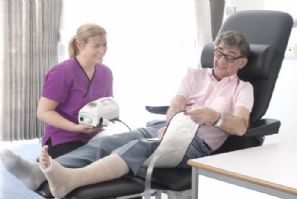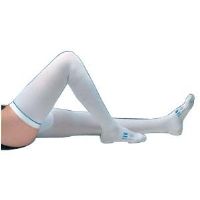 Written by Benjamin K. Mattox, DrPH, PA-C
Written by Benjamin K. Mattox, DrPH, PA-C
Venous leg ulcers (VLUs) are common and often chronic wounds that result from poorly functioning venous circulation. Frequently accompanied by comorbidities including diabetes, obesity, and venous insufficiency the healing time of VLUs can be upwards of 3-4 months even with optimal treatment. Besides causing individuals pain and suffering, the cost of venous leg ulcer treatment can be astounding and rise upwards of $35,000 for even a single episode.
With such a high incidence and cost to both the patient and the healthcare system as a whole, management must be both timely and comprehensive. Follow along as we review the etiology, symptoms, and some associated treatment options for venous leg ulcers.
 | WoundExpress Intermittent Pneumatic Compression (IPC) Machine by Arjo View Product |
Venous leg ulcers are chronic open sores that develop secondary to poor vein flow or venous circulation. They are most commonly seen in the lower leg near the ankle and arise when the veins have difficulty pumping deoxygenated blood back to the heart. Venous leg ulcers can be recurring, are often extremely painful, and can take a long time to heal. In addition to causing significant discomfort to the patient, these ulcers create long-term issues and are associated with growing healthcare costs.
The symptoms of each venous leg ulcer may vary but some commonly seen traits include:
In some cases, venous leg ulcers can form after a traumatic injury, however, most arise secondary to an underlying condition. The veins in your legs are responsible for carrying deoxygenated blood from the legs up to your heart. Due to their anatomic position and need to push blood up against gravity, these veins have one-way valves that prevent backflow and stave off blood pooling. If these valves are dysfunctional or circulation is poor, blood can collect in the legs. This pooling increases the pressure on the skin and surrounding tissues and with time leads to chronic swelling and ulcerations. Open exposure of the skin to air can lead to pain, bacterial infiltration, and infection.
Treatment for venous leg ulcers is often multi-faceted and involves addressing both the symptoms and the underlying cause. If an ulcer is present, ointments, pain relievers, specialized bandaging, and antibiotics all are treatment options to promote infection mitigation and pain management. Specialized procedures such as wound cleaning and debridement may also be employed to remove necrotic tissue and flush out bacteria. More advanced methods and technologies include intermittent pneumatic compression machines.
The Wound Express from Huntleigh with IPC is our favorite. Although tailored specifically for VLUs, it can treat most lower limb wounds and works by directing compressive pressure AWAY from the wound site. This product is easy to apply, has the potential for other uses and can be performed in the comfort of your own home.
For a venous leg ulcer to effectively heal, the pressure in the veins must be relieved. In addition to a specialized pneumatic compression machine, these traditional methods can also help.
 | Thigh Length Anti-Embolism Stockings by T.E.D View Product |
When our body’s natural pumping mechanisms fail, external compression socks and stockings can be used to encourage directional blood flow. Although they relieve pressure and are very effective in certain situations, these devices have to go directly over the ulcer and typically require many layers to be effective. For some, this can cause discomfort and exacerbate pain, itchiness, and skin irritation.
Recommended: Thigh Length Anti-Embolism Stockings by T.E.D
Another simple method to reduce pressure is to elevate the legs. Doing so uses the assistance of gravity to help return blood flow to the heart. Whether you use standard pillows or specialized leg elevation wedge pillows, ensure your legs are above the height of the heart to be the most effective.
A final recommendation for effective venous ulcer management is incorporating regular exercise into your daily routine. Static positioning tends to exacerbate pooling while active movement, walking, and exercise all promote circulatory benefits that help mobilize static fluid. Controlling body weight through diet and exercise can also improve the severity of symptoms associated with venous leg ulcers.
With 2% of individuals over the age of 80 experiencing active venous leg ulcers, this condition is both cumbersome and costly. Although VLUs are very specific and well-studied wounds, there are not many advanced treatments available on the market to manage them. Luckily, Huntleigh is a trusted brand that is bringing the latest treatment to users at home. Combined with preventative measures, intermittent pneumatic compression can be an effective tool to reduce the symptoms of venous ulcers and minimize the chronicity of the condition.
If you or someone you know is suffering from VLUs, head to our expert-curated blog, Caregiver University, to learn more about related products and treatment options, and make the most informed medical buying decisions.

Benjamin K. Mattox, DrPH, PA-C
Orthopedic surgery physician assistant, doctor of public health, and owner of a public health consulting firm. With over a decade of Active Duty Navy Experience, Deployments with the Navy SEALS, and as a Professor for Purdue University - Dr. Mattox is a highly qualified and experienced clinician with a firm understanding of orthotic needs, rehabilitation, home access needs, gait therapy, and veteran-specific health needs.